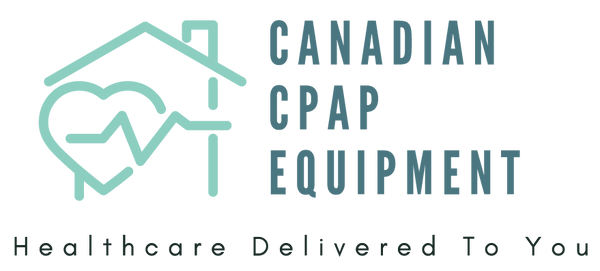At-home sleep apnea test (also known as HSATs) are quickly gaining popularity across Canada and for good reason. These tests offer a convenient, accessible, and accurate way to screen for sleep apnea from the comfort of your own bed. As technology continues to advance, at-home diagnostics are becoming a reliable alternative to traditional in-lab sleep studies.
One standout in this space is the WatchPAT ONE, sleep apnea test at home. Although relatively new to Canada, it's already making waves in the world of sleep disorder detection. Unlike many over-the-counter sleep monitors that only track general sleep patterns, the WatchPAT ONE is Health Canada and FDA-approved for diagnosing sleep apnea.
In this guide, we’ll explore the different types of home sleep tests available, what to look for when choosing a device, and how to decide which option is best for your needs.
Home Sleep Apnea Test vs. Sleep Monitoring Devices
It’s important to understand the difference between Home Sleep Apnea Tests (HSATs) and sleep monitoring devices, as they serve very different purposes.
Home Sleep Apnea Tests (HSATs)
✔️ Diagnose Obstructive Sleep Apnea (OSA)
✔️ Some can also detect Central Sleep Apnea (CSA)
✔️ Use medical-grade sensors and validated algorithms
✔️ Measure oxygen levels, breathing patterns, heart rate, and sleep stages
✔️ Approved by Health Canada and the FDA for diagnosis
✔️ Results are reviewed by a sleep-trained physician who provides a formal diagnosis and treatment plan
- Example: WatchPAT ONE – easy to use, accurate, and done at home
Sleep Monitoring Devices
✔️ Track general wellness data: sleep duration, heart rate, movement, and oxygen saturation
✔️ Cannot diagnose sleep apnea
✔️ Helpful for identifying patterns that suggest a sleep study may be needed
✔️ No physician review or formal diagnosis
- Examples available in Canada:
- Apple Watch (Series 6 and newer)
- Fitbit Sense and Charge 5
- Oura Ring Gen 3
- Garmin Vivosmart 5
|
Home Sleep Apnea Test (HSAT) |
Sleep Monitoring Device |
|
Approved for diagnosis |
Not approved from diagnosis |
|
Measures apnea events |
Tracks general sleep trends |
|
Interpreted by a sleep physician |
Self-monitored data |
|
Leads to treatment |
Suggests you may need a HSAT |
Key Takeaway:
Sleep monitors are great for general tracking, but if you’re concerned about sleep apnea, an approved home sleep test is the next step toward an official diagnosis and treatment.
Why a Clinical Diagnosis Matters
A Home Sleep Apnea Test (HSAT) provides more than just information about your sleep—it offers a clear path to diagnosis and treatment. Once the data is collected, a sleep-trained physician reviews the results, confirms whether sleep apnea is present, and recommends the next steps for treatment.
This level of accuracy and medical oversight isn’t possible with sleep monitoring devices. While wearables like smartwatches and sleep trackers can suggest there may be a problem, such as frequent oxygen drops or restless sleep, they don’t collect enough clinically relevant data to make a formal diagnosis.
And without a proper diagnosis, a treatment plan can’t be started. That means you could be stuck in the same cycle of poor sleep, health risks, and daytime fatigue without a clear solution.
How to Know If You Need a Home Sleep Apnea Test
A home sleep apnea test (HSAT) is a simple, effective way to check for sleep apnea, all from the comfort of your own bed. But how do you know if it’s time to get tested?
You may be a good candidate for a home sleep apnea test if you’re experiencing:
✅ Daytime fatigue, even after a full night’s sleep
✅ Loud snoring, choking, or gasping for air during sleep (often noticed by a bed partner)
✅ Morning headaches
✅ Frequent nighttime awakenings, especially to urinate
✅ Difficulty concentrating or feeling foggy during the day
If these signs sound familiar, a home sleep apnea test can provide the answers you need. Early diagnosis is key to improving your sleep, protecting your health, and boosting your quality of life.
Ready to take the next step?
A home sleep apnea test is simple, convenient, and delivers accurate results, no overnight sleep lab required.
👉 Book your home sleep apnea test today and take the first step toward better sleep and better health.
Frequently Asked Questions (FAQ)
A Home Sleep Apnea Test (HSAT) is a medical test you do at home to check for sleep apnea. It records data like breathing patterns, oxygen levels, and heart rate while you sleep. A sleep-trained physician reviews the results and provides a formal diagnosis if sleep apnea is detected.
For individuals with a high likelihood of obstructive sleep apnea (OSA) and few other health issues, HSATs are highly accurate. They offer reliable results that are often comparable to an in-lab polysomnography for diagnosing OSA.
No. Devices like the Apple Watch, Fitbit, or Oura Ring can track general wellness data (like sleep quality and oxygen levels) but cannot diagnose sleep apnea. Only a clinical-grade home sleep test or in-lab study can provide a formal diagnosis.
Home sleep tests are best for people who are suspected of having moderate to severe obstructive sleep apnea and have minimal other health conditions. You may be a good candidate if you:
✔️ Snore loudly
✔️ Experience daytime fatigue
✔️ Wake up frequently during the night
✔️ Have morning headaches
✔️ Have a bed partner who notices gasping or choking sounds during your sleep

